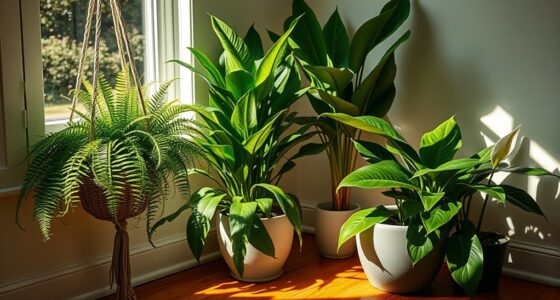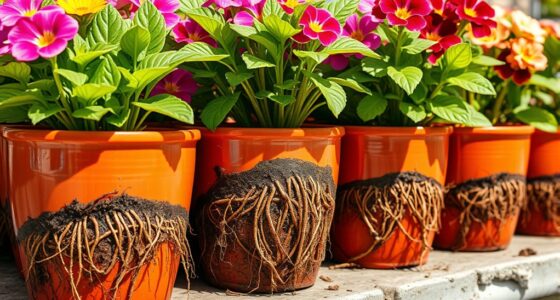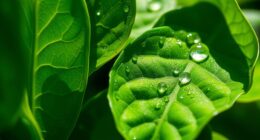To choose the best DIY potting mix for indoor plants, start with a base of high-quality peat moss or coconut coir for moisture retention. Add perlite, pumice, or coarse sand to improve drainage and aeration, and incorporate compost or organic matter for nutrients. Adjust proportions based on your plant’s needs—more drainage for succulents, richer mix for tropicals. For ideal growth, it’s essential to match your mix with your plant’s watering habits, so continue exploring for more tips.
Key Takeaways
- Match soil moisture retention to your plant’s watering needs, choosing mixes that are either moisture-retentive or well-draining.
- Incorporate drainage-enhancing components like perlite, pumice, or coarse sand for better aeration and water flow.
- Use high-quality organic materials such as peat moss or coconut coir to support consistent moisture levels.
- Adjust the proportion of organic matter and drainage agents based on whether your plant prefers dry or moist soil.
- Ensure containers have drainage holes and consider elevating pots to prevent waterlogging and improve airflow.

Selecting the right potting mix is essential for keeping your indoor plants healthy and thriving. The type of soil you use directly affects how well your plants absorb water, nutrients, and oxygen. One of the most important considerations is understanding your plant’s watering frequency. Some plants prefer consistently moist soil, while others thrive in drier conditions. If you overwater or underwater, it can lead to root rot or dehydration. Matching your watering schedule to the potting mix’s properties ensures your plants get the right amount of moisture without sitting in waterlogged soil.
Choosing the right potting mix ensures your indoor plants thrive by matching soil moisture with watering habits.
Container drainage plays a critical role in this process. When choosing or making your potting mix, you want a blend that promotes good drainage to prevent excess water from pooling at the bottom of your container. Poor drainage creates soggy soil, inviting fungal diseases and root rot. To improve drainage, incorporate components like perlite, coarse sand, or bark into your mix. These materials create air pockets that allow excess water to escape quickly, keeping the roots healthy and oxygenated. When you water, the soil should feel moist but not muddy or waterlogged. Check how the water moves through the soil after watering; if it pools or takes too long to drain, reevaluate your mix or container choice.
If your container has drainage holes, this makes it easier to manage watering frequency because excess water can escape freely. Without proper drainage, even a well-draining mix will sit in water, risking plant health. Always ensure your pots have drainage holes and consider elevating them slightly to improve airflow underneath. This helps prevent water from accumulating at the base, which can cause root problems. Additionally, understanding the signs of poor drainage can help you troubleshoot and adjust your potting mix accordingly.
When creating your own DIY potting mix, start with a base of high-quality peat moss or coconut coir for moisture retention, combined with perlite or pumice to enhance drainage and aeration. Add compost or organic matter for nutrients, but keep the soil light and fluffy. Adjust the proportions based on your plant’s needs—more drainage components for succulents, richer mixes for tropical plants. Remember, consistency is key: a well-balanced mix tailored to your plant’s watering needs and container drainage will make caring for your indoor garden much easier and more successful. Proper soil setup minimizes watering stress and keeps your plants happy and healthy in their indoor environment.
Frequently Asked Questions
How Often Should I Repot My Indoor Plants?
You should repot your indoor plants every 1-2 years or when they outgrow their current pot. Keep an eye on your watering schedule; if the soil dries out quickly or roots become crowded, it’s time to repot. Regular repotting encourages healthy growth and prevents root-bound issues. Adjust your repotting frequency based on the plant’s growth rate and overall health to keep them thriving indoors.
Can I Reuse Potting Mix From Previous Plants?
Yes, you can reuse potting mix from previous plants, but soil sterilization is essential first. Reusing soil saves money and resources, but it may harbor pests or diseases. To avoid this, break up the old soil, sterilize it by baking at 180°F (82°C) for 30 minutes, or treat with a natural disinfectant. This process helps make sure your new plant grows healthy in a safe, nutrient-rich environment.
What Are Signs of Poor Drainage in Potting Mix?
You’ll notice poor drainage when your plant’s soil retains too much water, leads to soggy roots, and causes issues like root rot. If water pools on the surface, drains slowly, or the soil stays wet long after watering, these are signs of inadequate drainage. Your plant might also show yellowing leaves or wilting despite regular watering. Good drainage ensures excess water escapes, keeping roots healthy and preventing root rot.
Are Natural or Synthetic Ingredients Better for DIY Mixes?
Natural ingredients are generally better for DIY potting mixes because they provide better aeration, moisture retention, and nutrients, supporting healthy plant growth. Synthetic components can improve drainage and consistency but might contain chemicals that aren’t ideal for sensitive indoor plants. You should balance both, prioritizing natural ingredients like compost, peat, or coconut coir, while using synthetic components sparingly to enhance specific properties like drainage or pH adjustment.
How Do I Adjust Ph Levels in Homemade Potting Mixes?
To adjust pH levels in your homemade potting mix, start with pH testing using a reliable kit. If the mix is too acidic, add lime gradually and mix thoroughly, then re-test until you reach the desired pH. For alkaline mixes, you might consider adding sulfur or peat moss. Always test after each adjustment to avoid overcorrecting, ensuring your plants thrive in a balanced environment.
Conclusion
Picking the perfect potting mix is like finding the secret ingredient to a flourishing garden. When you choose wisely, your indoor plants will thrive like a symphony of green, each leaf reaching for the sun. Think of your mix as a cozy bed where roots can wiggle and grow freely. With the right recipe, your indoor jungle will flourish, turning your space into a lush oasis that feels like a gust of fresh, living art.









